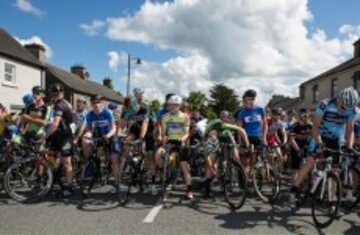SO YOU’VE BEEN bitten by the cycling bug, pretended you knew more than you did when you bought the bike, and were too proud to quiz the guy in the shop about what happens next.
Now you’re in rush hour traffic with a bike that’s squeaking and rattling and if you’re only answer to remedy this incessant noise is turning up the sound on your iPod, then you’re in major danger.
Here are five mistakes every beginner cyclist makes.
-
Improper bike fit
This is a crime. It looks bad and it feels bad and is the number one reason why beginner cyclists don’t go any further than the 5k commute to work.
A proper bike fit is the single most important thing you can do when you buy a bike and if the shop where you bought it won’t provide one, then go seek help and advice from someone who will. Spending €100 on a bike fit might seem a complete waste of money, given you just throw the legs over the crossbar and pedal, right? Incorrect. If you’re comfortable riding the bike, that is, not feeling any pain anywhere, you’ll go further, get fitter, enjoy it more and save money.
There are several ways to adjust the bike, be it changing the stem, seat height, handlebar angle or position of the saddle. So if you’re unsure, go to a bike shop and pay the money. There is a science behind it.
-
Tyre pressure
This has a huge bearing on how your bike will feel when you ride. Tyre pressure is directly related to how well the bike handles on corners and how fast you can go. The correct tyre pressure also lengthens the life span of your tyre and makes them more resistant to punctures. On each tyre there will be a number (40-120psi, generally) which tells you how much pressure it can tolerate. The lower number is the minimum, higher is maximum.
A lower pressure will provide less rolling resistance so you will need to pedal harder to go the same distance as someone with a tyre pressure of say 120psi. On the flipside, a harder tyre provides slightly less grip, especially in the wet and you will not get as smooth a ride. A good idea is to go softer on the back tyre than the front because you have more weight on the back, as you’re sitting down on it. You will need two types of pump as a cyclist; a track pump and a hand pump. The former is much more robust and can give the tyre the hardness the latter won’t. Though it will get you home if you puncture.
-
Not learning how to fix a flat tyre
This probably happens everyone and it’s only when it happens and after you’ve made the dreaded phone-call home that you pledge to learn how to repair your own tyre. To fix a tyre you need a spare tube, a set of tyre levers (two will suffice) to pull the punctured tube out from inside the tyre and a hand pump which fits neatly into your pack pocket, handbag, or straps nicely to some part of the frame of the bike.
Fixing a tyre should take no more than seven minutes and for the best tutorial on how to do it, watch below:
-
Clean that chain
By looking after your bike you’re ensuring it works smoothly every time and by far the most important components to keep clean are the chain and the cassette (the series of toothed sprockets on the back wheel that propels the bike). A dirty chain will wear easily because think of it, you’re riding in the wet and the mud, grit and grease on the road gets picked up by the wheels and spat onto the chain.
This constant friction with the cassette wears down the chain and it becomes ‘loose’, thus gear-shifting becomes hindered and before long, if untreated, the chain will start ‘skipping’ and you risk an accident. Clean the chain by spraying it with a good degreaser, working it in with a toothbrush, give the degreaser 3-4 minutes to work its magic and finally, rinse off with a sponge and warm bucket of water. Dry the chain afterwards and apply a ‘wet lube’ liberally, wiping down again afterwards. Job done in five minutes.
-
Loose helmet
Okay so they’re not the most stylish things you can wear and the cheaper ones can be particularly awful, resembling something out of the film Groundhog Day. But spend the money on a good helmet because it’s one of the best things you can buy for the bike. And when you buy it, make sure it fits properly. Finally, ensure the helmet is resting just above your eyebrows and it cannot rotate around your head or slip sideways.








No mention of tonight’s big game Steven or who you fancy?
No mention of tonight’s big game Steven or who you fancy? The game of the weekend I would have thought!
I think the 49ers will bounce back but I don’t think it’ll be all that great a game. I think it could come in under 30 points total.
It was even worse than I thought it would be! Seahawks-49ers is the new Steelers-Ravens, first touchdown wins.
Rams to beat the Packers?? Did you not see how good Rodgers was last week?
I did. But I also saw him (and the entire team) against the Seahawks, Colts and 49ers.
The Rams are 3-0 at home. The Packers are 1-2 on the road. The Rams rank fifth against the pass and the Packers can’t run the ball. So many reasons to go with St. Louis.